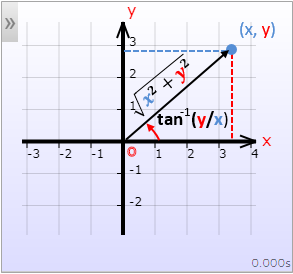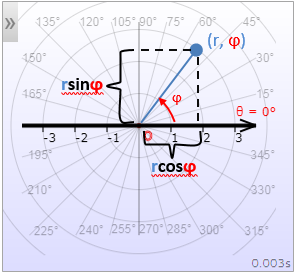
An ordered pair (a,b) typically locates a different point in the Cartesian coordinate system than in the polar coordinate system (assuming the same origin). To see this, plot, for example, the point (1,1) using this Cartesian and polar points grapher. The question then arises: Given the coordinates of a point in one system, what are its coordinates in the other system?
To answer this question, we assume that in the Cartesian coordinate system, the independent axis is horizontal, and the dependent axis is vertical. We also assume that the polar axis coincides with the x-axis, shares the same origin, and both Cartesian axes and the polar axis have the same scales.
Note (Complex Number Conversion): For those familiar with complex numbers, or for users of complex number calculators like our complex number converter, the conversion here is analogous to converting between rectangular and polar/phasor forms of complex numbers. By noting that the complex number a + bi can also be represented by the ordered pair (a,b), the following conversion formulae can also be applied to complex number conversion.
As shown in the following figure, regardless of the location of the point (x,y), we have, by the Pythagorean Theorem r =√(x2 + y2)
We also have tan(φ) = y/x where φ is the polar angle (or phasor) — the angle that the vector (a, b) makes with the positive x-axis, or the argument of the complex number a+bi.
By definition of tan-1, we have φ = tan-1(y/x) if (x,y) is in the first or fourth quadrant (where x > 0), as tan-1 always gives an angle between -π/2 and π/2.
Note that the above also holdes for x = 0, which implies r = |y|, and φ = ±∞ depending on the sign of y.
If (x,y) is in the second or third quadrant (where x < 0), we must add or subtract π to tan-1(y/x) to obtain the correct polar angle.

To summarize:
Cartesian (Rectangular) to Polar (Phasor) Form
For a point with Cartesian coordinates (x,y), the polar form is:
(r,φ), where
In the trivial case where both x any y are 0, we get r = 0, and φ can be any number such as 0.
Note that φ is not unique, they all differ by an integer multiple of 2π.
In terms of the complex number z in the rectangular form x+yi, the phasor form is:
r∠φ
which is defined as reiφ — via Euler's formula)
(r and φ are defined as above — r is called the length (or modulus or magnitude) and φ is called the argument of the complex number).
Note that the argument of a complex number (arg(z)) is not unique, they all differ by an integer multiple of 2π.
Converting polar coordinates to Cartesian coordinates is straightforward using the definitions of trigonometric functions on a trig circle. Referring to the following figure, it is clear that the point (r,φ) in the polar coordinate system and the point (rcos(φ), rsin(φ)) in the Cartesian coordinate system coincide.

So we have the following formula for converting polar coordinates to Cartesian coordinates:
Polar (Phasor) to Cartesian (Rectangular) Form
For a point with polar coordinates (r,φ), the Cartesian form is:
In terms of the complex number in the phasor form r∠φ, the rectangular form is:
Note: The above conversion formula holds even if r is negative. If r < 0, then x = -|r|*cosφ = -(-r)*cosφ = r*cosφ, and similarly, y = -|r|*sinφ = -(-r)*sinφ = r*sinφ.